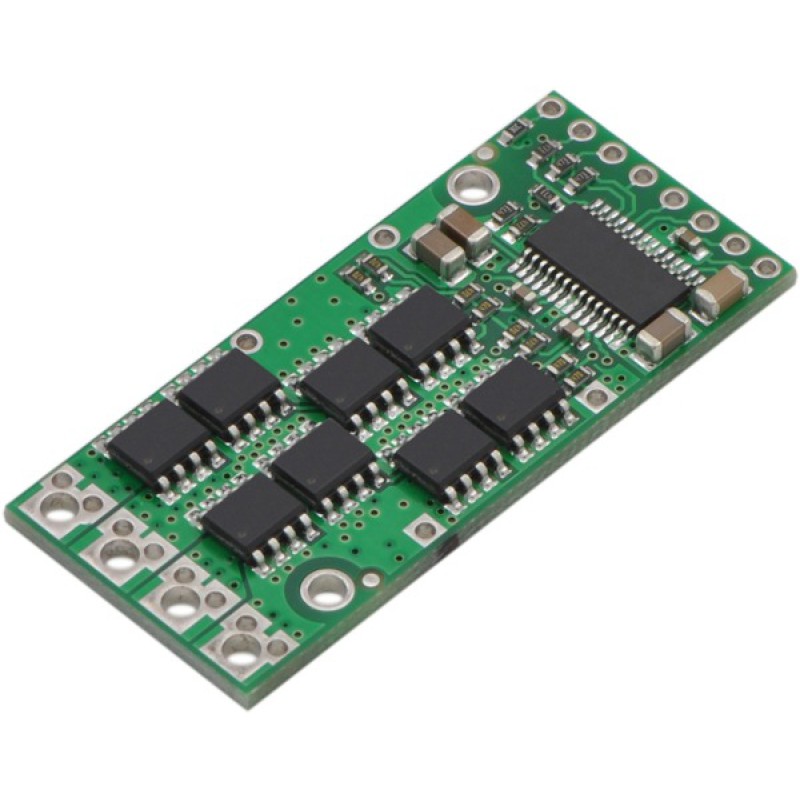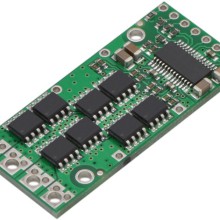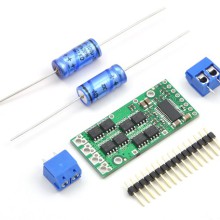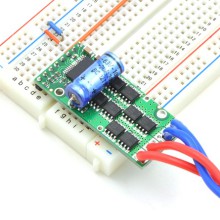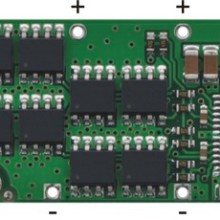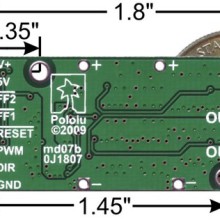Pololu High-Power Motor Driver 18v25
The Pololu high-power motor driver is a discrete MOSFET H-bridge designed to drive large DC brushed motors.
The H-bridge is made up of two N-channel MOSFET per leg, and most of the board’s
performance is determined by these MOSFETs (the rest of the board
contains the circuitry to take user inputs and control the MOSFETs).
The MOSFET datasheet is available under the “Resources” tab.
The MOSFETs have an absolute maximum voltage rating of 30V, and higher voltages can permanently destroy the motor driver.
Under normal operating conditions, ripple voltage on the supply line can raise the maximum
voltage to more than the average or intended voltage, so a safe maximum voltage is approximately 24V.
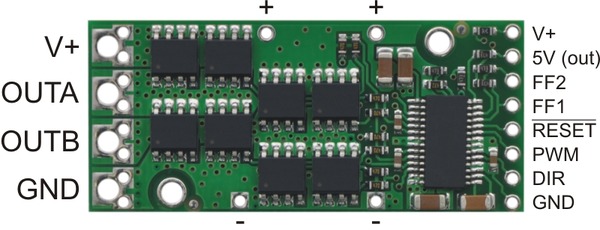
The versatility of this driver makes it suitable for a large range of currents and voltages:
it can deliver up to 25A of continuous current with a board size of only 1.8" by 0.8" and no required heat sink.
With the addition of a heat sink, it can drive a motor with up to about 35A of continuous current.
The module offers a simple interface that requires as little
as two I/O lines while allowing for both sign-magnitude and locked-antiphase operation.
Integrated detection of various short-circuit conditions protects against common causes
of catastrophic failure; however, please note that the board does not include
reverse power protection or any over-current or over-temperature protection.

Using the Motor Driver
Connections
The motor and motor power connections are on one side of the board, and the control connections (5V logic) are on the other side.
The motor supply should be capable of supplying high current, and a large capacitor should be installed close to the motor driver.
The included axial capacitors can be installed directly on the board
in the pins labeled '+' and '-' as shown below. Such installations are compact but might limit heat sinking options;
also, depending on the power supply quality and motor characteristics, a larger capacitor might be required.
There are two options for connecting to the high-power signals (V+, OUTA, OUTB, GND):
large holes on 0.2" centers, which are compatible with the included
terminal blocks, and pairs of 0.1"-spaced holes that can be used with perfboards, breadboards, and 0.1" connectors.
The logic connections are designed to interface with 5V systems (5.5V max);
the minimum high input signal threshold is 3.5V, so we do not recommend connecting this device
directly to a 3.3V controller. In a typical configuration, only PWM and DIR are required.
The two fault flag pins (FF1 and FF2) can be monitored to detect problems
(see the Fault Flag Table below for more details). The RESET pin, when held low, puts the driver into
a low-power sleep mode and clears any latched fault flags.
The V+ pin on the logic side of the board gives you access to monitor the
motor’s power supply (it should not be used for high current).
The board also provides a regulated 5V pin which can provide a few milliamps
(this is typically insufficient for a whole control circuit but can be useful as a reference or for very low-power microcontrollers).
PWM Frequency
The motor driver supports PWM frequencies as high as 40kHz,
though higher frequencies result in higher switching losses in the motor driver.
Also, the driver has a dead time (when the outputs are not driven)
of approximately 3us per cycle, so high duty cycles become unavailable at high frequencies.
For example, at 40kHz, the period is 25us; if 3us of that is taken up by the dead time,
the maximum available duty cycle is 22/25, or 88%. (100% is always available, so gradually ramping the
PWM input from 0 to 100% will result in the output ramping from 0 to 88%,
staying at 88% for inputs of 88% through 99%, and then switching to 100%.)
מידות
| Size: | 1.8" x 0.8" |
|---|---|
| Weight: | 4.2 g1 |
מאפיינים כלליים
| Motor channels: | 1 |
|---|---|
| Minimum operating voltage: | 5.5 V |
| Maximum operating voltage: | 30 V |
| Continuous output current per channel: | 25 A2 |
| Maximum PWM frequency: | 40 kHz3 |
| Maximum logic voltage: | 5.5 V |
| MOSFET on-resistance (max per leg): | 1.8 mΩ |
| Reverse voltage protection?: | N |

